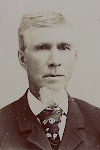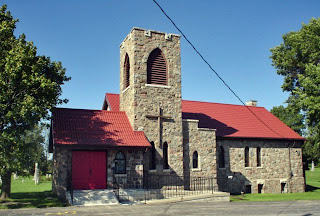“When Harry Protestant Met Sally Catholic”
Protestantism and Catholicism in the Greater Ducklow Family
[Published June 29, 2010, Updated July 30, 2010]
St. Paul's Episcopal Church, Ashippun
Our common ancestral grandparents, Thomas and Elizabeth Ducklow [Dukelow], were faithful and devote members of St. Pauls’s Church in Ashippun, Wisconsin [see footnote]. St. Paul’s is an Anglican-based Episcopal church. Thomas and Elizabeth were active church members and no doubt were tightly connected to their faith community from the earliest days of craving-out a homestead in the wilderness of Wisconsin in the mid-1840s until their last days that God gave them breath on Earth. Evidence of their devotion is seen in the church records that show all of their children born in Wisconsin were baptized at St. Pauls’s [see footnote]. While it is not known if Thomas and Elizabeth knew each other while each lived in Ireland (the earliest evidence of their meeting is when they wed in New York State) they each likely came to their protestant faith in a similar way: As children and young adults they attended the dominate Anglican Church of Ireland. They developed a protestant world-view by adopting their parents’ and extended families’ beliefs and by formal and informal church teachings of the Anglican Church.
From the late 1600s until nearly the end of the 1900s the religious and political climate in Ireland was highly polarized around beliefs. Simply put, Catholics and Protestants were socially and religiously segregated—they lived in two distinct subcultures. Protestants were the minority population of Ireland but held most of the political power while Catholics were the majority population but had few positions of authority outside of the Roman Catholic Church. There is a long history of how this came to be—a complicated history that reaches back into the 1300s that will not be detailed here. But one result of the unfolding of this history was the creation of a set of statutes, called Penal Laws, which, among many things, forced generations of Catholics to be uneducated and therefore illiterate, unskilled and impoverished. Penal laws rarely allowed Catholics to ascend their poverty, and forced most to remain in Ireland’s lowest social and working classes.
The opinion held by most Irish Protestants living in the 18th, 19th and 20th centuries, and the view likely embraced by our ancestral grandparents, Thomas and Elizabeth, is that Catholics were not to be socialized with, and certainly not were worthy of marriage to their sons or daughters. After years of imposed Penal Laws, Catholics (from a Protestant view) became synonymous with being uncouth, unrefined, uneducated and ill mannered. If any of Thomas and Elizabeth’s 11 adult children had married someone from the Catholic faith they very likely would have been shunned and disowned. Such a decision would have been a serious betrayal to a family that took enormous risks to immigrate to America to improve their own economic and social standing. Even as the Irish Penal Laws were phased out in the late 1700s and into early 1800s, marriage of a Protestant to a Catholic was viewed an economic, social, religious step down.
First Known Ducklow Protestant / Catholic Marriages
The barrier to marrying Catholics propagated through the Ducklow descendants for many years. This can be seen by reviewing the number of Protestant / Catholic marriages at each generation. Of course it is no surprise that no one in the first generation—that is Thomas and Elizabeth’s children—married a Catholic spouse. The barrier was eventually crossed in the second generation. Of Thomas and Elizabeth’s 30 grandchildren, three are known to married Catholic spouses.
Vern and Mina Ducklow and first child, Lamont. Circa 1909
Vern Ducklow was the first cross the line, so to speak. He was the son of George and Emma Ducklow (George was Thomas and Elizabeth’s sixth child). Vern married Mina Bowen in July of 1907. While it is true that Mina was Catholic, Vern and Mina did not marry in a Catholic church, but rather wed in a civil ceremony in Denver, Colorado. Through the years Vern was not a regular church attendee, Catholic or otherwise. He was baptized at age 79 in the Congregational Church (Vern died at age 81) and he apparently attended church more frequently at the end of his life. Mina appears to have practiced her Catholic faith on an irregular basis too, but perhaps was more connected to a church than Vern. Near her death she was given last rites and upon death had a Catholic funeral. None of Vern or Mina’s four children practiced the Catholic faith.
Clayton Ducklow, Circa 1908
The second Thomas and Elizabeth grandchild to break the Protestant / Catholic barrier was Clayton Ducklow, youngest brother of Vern. Clayton married Mary Magdalene McMenamin in September of 1910. (Could there a name more Catholic than that?) Clayton converted to Catholicism shortly before or after his marriage to Mary and appears to have been an active member of the Catholic Church his entire married life. All six of Clayton and Mary’s children were devote Catholics.
It seems George and Emma Ducklow, while members of the Methodist Church and perhaps the Congregational Church, did not hold strong religious convictions and did not appear to be regular attendees of a church. One wonders if this lack of a strong church connection allowed them a more liberal position and a willingness to accept two of their son’s decisions to marry Catholic women. Also, the guiding influence that Grandparents Thomas and Elizabeth might have had on George and Emma’s children was likely very limited due to the distance George lived from his parents (The distance from Spring Valley to Ashippun is about 260 miles, a difficult span to travel by horse). It is also note-worthy that both Thomas and Elizabeth had passed-away (in 1892 and 1904 respectively) before any of their grandchildren married spouses of the Catholic faith.
Elmer Ducklow Circa 1900
The third Ducklow grandchild of Thomas and Elizabeth to marry a Catholic spouse was Elmer Ducklow, son of Charles and Eva Ducklow (Charles was Thomas and Elizabeth's seventh child). Elmer and Elizabeth Wagner married in January of 1911. It appears that Elmer did not convert to Catholicism as he was not buried with his wife in the Catholic cemetery; he is buried near his parents in the Sparta city cemetery. Elmer and Elizabeth’s only child, Lyle, was a practicing Catholic.
Outside of these three grandchildren, all other 27 grandchildren married spouses that either had no clear church affliction, or were also Protestants. Thomas and Elizabeth’s apparent strong influence over the faith values of their children and grandchildren spanned from the marriage of their first daughter, Mary Ann’s in 1865 through the final marriage of their grandson Frank Ducklow Sr. in 1948.
Protestant / Catholic Marriage Three Generations Removed
It was not until the great grandchildren grew-up to marriage-age that the strong Catholic / Protestant divide was distant enough in history to ignore or perhaps be unaware of. Of 79 great grandchildren, 12 are known to marry Catholic spouses. This is a ratio of 1 out of 7 marriages. Compare this to the ratio of 1 out of 10 marriages at the grandchildren level.
Here is the list of 12 great grandchildren that that married Catholic spouses:
(1) Evaline Good (daughter of James and Effie Good, granddaughter of Mary Ann Ducklow and Frank Good) married Francis “Con” Hogan in June of 1917. Evaline was reported to have attended both Catholic and Protestant services much of her married life.
(2) Ida LaGrander (daughter of Nellie and George LaGrander, granddaughter of George and Emma Ducklow) married Daniel Smith in May 1924.
(3) George LaGrander (son of Nellie and George LaGrander, grandson of George and Emma Ducklow) married Genevieve Strop in June 1928.
(4) Lyle Ducklow (son of Elmer and Elizabeth Ducklow, grandson of Charles and Eva Ducklow) married Loretta Rice in October of 1936.
(5) Winnifred Ducklow (daughter of Clayton and Mary Ducklow, granddaughter of George and Emma Ducklow) married Living Lindee about 1940.
(6) Living P. Ducklow (daughter of Clayton and Mary Ducklow, granddaughter of George and Emma Ducklow) married E. Reynolds in June of 1946.
(7) Frank Ducklow Jr. (son of Frank and Josie Ducklow, grandson of George and Emma Ducklow) married Living G. M. in August 1946.
(8) Thomas Ducklow (son of Clayton and Mary Ducklow, grandson of George and Emma Ducklow) married Living W. O. in February 1950.
(9) George Ducklow (son of Clayton and Mary Ducklow, grandson of George and Emma Ducklow) married Living D. H. in February 1951.
(10) Milton Blair (son of Charles and Nellie Blair, grandson of John and Elizabeth Ducklow Hanson) married Living A. H. in1954.
(11) Mary Ducklow (daughter of Clayton and Mary Ducklow, grandson of George and Emma Ducklow) married Patrick Hannafin in 1954.
(12) Lyle Ducklow (son of Frank and Jessie Ducklow, grandson of George and Emma Ducklow) married Living M. T. in February of 1957.
Even as recent as the late 1950s, the Catholic / Protestant divide still echoed from our common grandparent’s past. Mae Tschida Ducklow recently told the story [see footnote] that shortly before being married to Lyle Ducklow (Frank Ducklow’s son), Lyle’s second oldest brother, Alois told Lyle that if he married a Catholic girl they would not be welcomed in Alois’ home. Lyle and Mae did not heed Alois’ threat and went on to marry. Eventually Alois’ did accept Lyle and Mae as part of the family, but an unspoken tension lingered between the brothers regarding Lyle converting to Catholicism.
Protestant / Catholic Marriages Four or More Generations Removed
Too little reliable marriage or church data has been gathered on the great, great grandchildren of Thomas and Elizabeth Ducklow to provide a fair analysis of Catholic / Protestant marriages in the Grater Ducklow family. As speculation, the ratio might be 1 in 4 or maybe 1 in 5 marriages crossing the Catholic / Protestant line, (if one or both spouses indeed attends a church at all!) What can safely be said is that a Protestant marrying a Catholic spouse today is hardly considered a scandal or a betrayal to one’s family or church as it did 125 years ago. A marriage formed today based on love and a desire to share lives together seems to have generally trumped the historic difficulty of marrying a spouse professing a different flavor of Christian faith.
❧
Footnote: The Episcopal Church in America is a legacy branch of Anglican Church of England. The Church of Ireland is also a legacy branch of the Anglican Church. As a broad statement of values, the Anglican churches views itself to be Catholic, in the sense that its beliefs and practices are based on traditions dating back to the beginning of a formal church, and also Reformed, in that it does not accept the authority of the Roman Catholic Pope.
Footnote: Thomas and Elizabeth’s children George, Charles, Baby Elizabeth, Elizabeth, James, Peter, and Lucinda were all baptized at St. Johns Episcopal Church. Thomas and Elizabeth were both buried in the church cemetery, as well as their children, Fanny, Thomas, and Lucinda.
Footnote: Charles and Eva Ducklow appear to have adopted the traditions of the Masonic Order and associated Eastern Star organization as their main religion. They were not married in a church, but rather at the Dunn County Courthouse. Their funeral services were performed by Masonic and Eastern Star traditions in a Masonic Temple. They are buried in the Sparta city cemetery, with Masonic symbols on their markers.
Footnote: The story of Lyle Ducklow being discouraged from marrying Catholic Mae Ducklow told to Jeff Ducklow by Mae Ducklow on June 27, 2010 at the home of Tony and Linda Ducklow.
Footnote: The author in no way condones the views held towards Catholics by our ancestors. The attitudes and behaviors can only be described as unjust.





